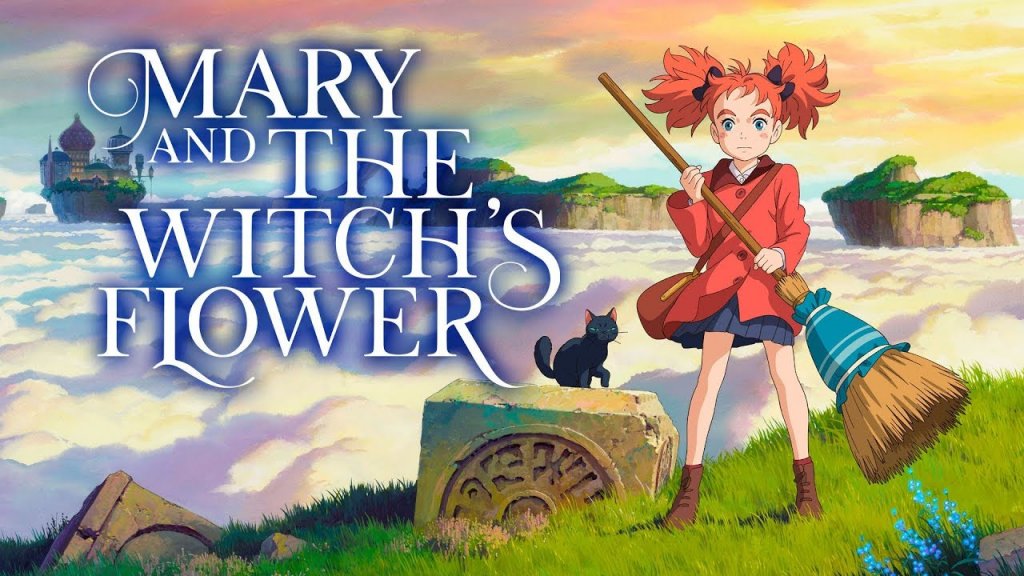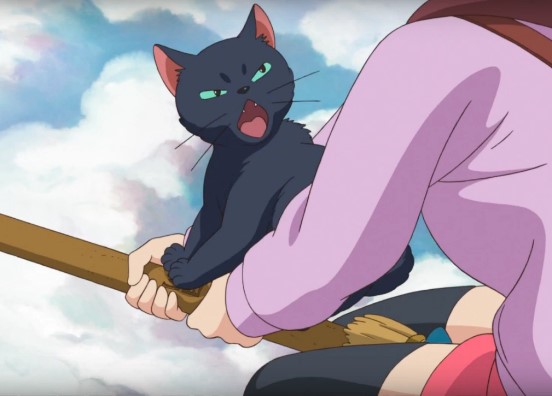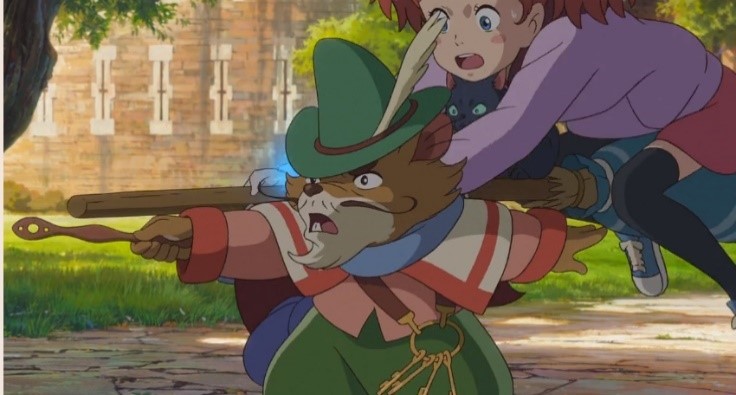Mary and the Witch’s Flower is a 2017 animated film, directed by Hiromasa Yonebayashi and produced by Studio Ponoc (founded by the former lead film producer at Studio Ghibli). The film tells the story of Mary, a little girl, who moves in with her Great Aunt Charlotte whilst her parents are abroad. When Mary is exploring the household estate, she stumbles upon a magical flower called “fly-by-night”, which provides her with the magic powers of a witch, however the magic only lasts one night. During this night, Mary discovers a school for witches and warlocks, where she meets the school’s headmistress (Madam Mumblechook) and its chemistry teacher and experimenter (Doctor Dee).
Mary and her friend Peter, find Doctor Dee’s secret laboratory where he transforms animals into monstrous creatures and monsters and then experiments on them. Mary rebels against the two teachers by finding a book that will reverse the magic that has transformed the creatures. This leads to the major conflict between Mary and her teachers, which ultimately ends in the animal’s release and the just punishment of Doctor Dee and Madam Mumblechook. To a degree the film abides by the typical genre conventions of witch and fantasy films, such as the inclusion of a feline familiar called ‘Tib’, and magical creatures (such as Flanagan, a talking badger who is the school’s caretaker). Like many Ghibli films which have preceded it, the film is concerned with the relationship between nature and technology, and they ways in which the continuing technological advancement and urbanization of rural Japan are altering Japanese culture as a whole. Animals are also used within the film to provide a warning to the viewer that mankind needs to respect wildlife and nature, as eventually it may turn on us (realistically however, this would be via diminishing yields or poor quality meat production, rather than a physically violent rebellion). Within the film the animals that are experimented on are used as representations of our destruction of the natural world, and the conflict that is currently taking place in contemporary Japan between modernity and traditionalism, and civilization and nature.
In the section of the film where Mary and Peter find the failed experiments that Doctor Dee has been keeping locked up underneath the school, we can clearly see how the animals within the film are being used as a representation for the way that Japanese culture and traditionalism has been altered by technology and modernity in a way that it has almost become unrecognisable. The animals used to be pure and natural (like traditional Japanese society used to be) but have been degraded and made almost grotesque in nature due to the experiments that have been performed on them (due to the technological advancements that have allowed this to take place). The grotesque nature of their appearance acts to cause the viewer to sympathise with the animals, as they have been deformed beyond recognition from what they formerly looked like. It is likely that this has been done to try and convince viewers to sympathise with nature and animals in the real world, perhaps to attempt to get people to think twice before taking animals and nature for granted. They are kept imprisoned in cages against their will (they can clearly be seen trying to get out of the cages), which exemplifies the ways in which we control animals and force them to carry out our bidding whilst they have no say in the matter. The lines of caged animals in this scene are highly reminiscent of battery egg farming, as the room is full of rows and rows of animals in small cages.
Towards the end of the film, Mary and Peter use magic to release all of the animals trapped in the school, who escape through a portal that takes them back into the real world via bubbles. The glow of the cages that the test subjects are kept in is not only magical, but also has a technological quality to it, as does most of the school. The escape of these animals represents a return to Japanese traditionalism, as the natural animals which have been distorted and experimented on by technology are returned to their natural state and returned to the wild. The experimented-on animals here exemplify the altered Japanese traditions and culture of today, as many traditions and cultural values have been altered by the introduction of technology and industry into Japanese culture (the animals here have also been altered by these forces, along with magic). By freeing the animals and stripping them of their altered/experimented on state, Mary is returning them to their traditional environment who they will thrive and prosper. This sequence also acts as a warning to viewers of our treatment of the natural world, as it brings attention to the way in which we treat animals (such as testing on them). It is therefore being suggested that perhaps it is better to live in harmony with nature, and to try and take care of it (as Mary and Peter are doing here) rather than trying to control or destroy it (as Doctor Dee has tried to do), as eventually our control over nature will be lost or taken from us (here it has been taken by Mary). Mary and Peter are helping the animals to escape in this scene, this exemplifies the way in which it is possible for humans to live in harmony with animals and nature, rather than having to live separately, as Mary and Peter are clearly able to collaborate with the animals during this scene and work together. This is also shown in the scene in the film where a deer helps Mary find her way back to the school and climb up to its entrance, this shows that Mary works together with nature and that the two are able to benefit each other (Mary helps nature by releasing the animals back into the wild and taking care of them, whilst the deer helps Mary by guiding her back to the school). This is a clear representation of the ways in which humans and animals/nature can have a mutually beneficial relationship, rather than one just exploiting the other.
It may also be suggested however, that even when the animals are released from the school through the portal, they are still to some degree imprisoned within their ‘bubble’. This exemplifies the way in which these animals will now experience freedom in the wild, but a freedom which is controlled and monitored by humans – as we control which areas animals are allowed to live in an where the boundaries of these region lie.
The warning that we need to stop exploiting nature is further exemplified through another shot at the end of the film, where the escaped animals turn on Madam Mumblechook and Doctor Dee and surround them in their broken vehicle, giving the impression they are going to violently attack them for their revenge. This scene is very reminiscent of the 1954 animated adaptation of George Orwell’s Animal Farm [1], when Napoleon and Snowball lead a violent rebellion against the farmers, driving them away from the farm and gaining their freedom. The framing of both shots is very similar, with the animals surrounding their captors in a circle, edging closer until they attack. It is through this rebellion that the animals in both films are able to gain their independence from humans and freedom, providing them with the ability to live as they should in the natural world. The shot of the animals surrounding Madam Mumblechook and Doctor Dee in their vehicle also acts as a visual representation of the opposition of nature and technological development that is a key theme of the film. Here the Doctor’s sleek metallic and industrial vehicle is juxtaposed by the green natural landscape and the organic animals the surround it, showing the difficulty in incorporating technological advancement within a traditionalist society/landscape.
The mutually beneficial relationship described earlier (Mary and the deer working together, and Mary and Peter releasing the animals and helping them to escape) is further demonstrated by Mary’s cat familiar ‘Tib’. Familiars are a key part of the mythology surrounding witches and are one of their key identifying characteristics. Mary and Tib work together and help each other carry out certain jobs during the film, their close relationship is companionship is shown by the fact that they ride close together on Mary’s broomstick. Tibs facial expressions throughout the film anthropomorphize him, providing us with the impression that he has cognitive levels similar to those of humans. This allows the viewer to sympathise with Tib and recognise him as being more than just an animal, this seems to have been done by the director to try and make it easier for the viewer to see and accept animals and humans working together in perfect harmony like Mary and Tib are. This companionship and mutual benefit between animals and humans can also be seen via the character of Flanagan, who helps Mary at various stages of her journey (such as helping her to escape and providing her with a new broom). Once again this exemplifies the way in which animals and humans can help each other and work together, rather than one trying to take control of the other. Similarly to Tibs, Flanagan is also anthropomorphized as he wears clothing, has a moustache and talks in a Scottish accent (all of which are characteristics of humans), which has been done to make an animal collaborating so closely with humans more acceptable to the viewer.
At the end of the film there are various shots of animals on Great Aunt Charlotte’s property, these include Aunt Charlotte’s domesticated pet dog, the cats Tib and Gib (transformed back from being a creature), and a wild butterfly moving through the garden. This is used as an example as to the ways in which animals are incorporated within human society, perhaps with the butterfly acting as a representation of new beginnings and allowing more nature into the human controlled space that is Aunt Charlotte’s house. It also shows the ways in which animals and humans are able to coexist within the same space. This return to nature and message of allowing more nature into our lives also acts as a parallel to allowing more Japanese traditionalism into modern Japanese culture, even if it is in small amounts. The end of the film is imbued with a sense of joy and peace, indicating that it is natural and right for these animals to be incorporated in the human-space that is Aunt Charlotte’s home, as they are living in peace with the humans and no chaos has been caused as a result.
Director Yonebayashi seems clearly to be using animals as a representation of the key oppositions which are at play within the film, such as modernity versus traditionalism, and civilization versus nature. Yonebayashi seems to clarify his stance on these conflicts through his use of animals within the film, he suggests that Japan needs to return to traditionalism and nature in order for its people to live in peace and harmony. This is because it is only through the stripping away of technology and augmentation from the animals, and their return to their natural habitat, that they are able to live in serenity and peace. In addition, the animals rebelling against those keeping them captive (Madam Mumblechook and Doctor Dee) serves as a warning for mankind, that we may not always be able to treat nature and wildlife as we like without suffering any consequences. In reality these consequences would not be violent rebellion from the animals, which is represented here, but rather diminishing yields of crops and reduced meat production (such as from overfishing). Mary and the Witch’s Flower therefore attempts to advise the viewer that they should embrace traditionalism and the natural world and attempt to find ways in which to work in harmony with animals/nature, rather than trying to change nature and animals with technology and modernity to fit our own needs.
Further Reading
Peter Bradshaw, Mary and the Witch’s Flower Review – Charming Japanese Children’s Adventure (2018) https://www.theguardian.com/film/2018/may/03/mary-and-the-witchs-flower-review-japanese-animation-hiromasa-yonebayashi [accessed 10 January 2018].
Nigel Howard, ‘Mary and the Witch’s Flower’ rivals ghibli films with its delightful animation. University Wire https://search/proquest-com.sheffield.idm.oclc.org/docview/1999739918?accountid=13828
Cassandra Atherton, ‘Japan and the Welfare of Companion Animals’, Japanese Studies, 16.1, (2016).
Rachel Tepper Paley, How Traditionalism and Modernism Coexist in Today’s Tokyo (206) https://www.travelandleisure.com/trip-ideas/modern-japanese-tradition [accessed 2 January 2019].
Matt Grobar, ‘Mary and the Witch’s Flower’ Director On Exploring World of Magic Through The Eyes Of A Young Girl (2017) https://deadline.com/2017/11/mary-and-the-witchs-flower-hiromasa-yonebayashi-oscars-interview-news-1202199618 [accessed 3 January 2018].
[1] Animal Farm, dir. by John Halas and Joy Batchelor (Distributors Corporation of America, 1954).






